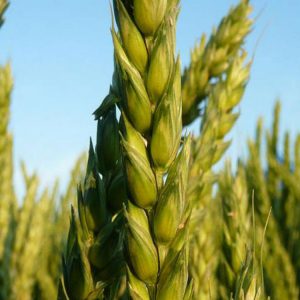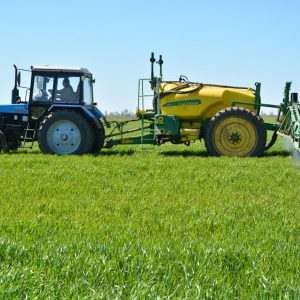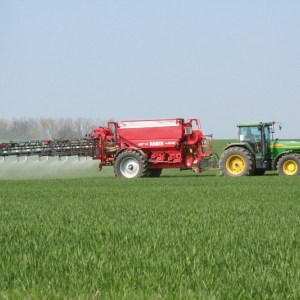Fertilizers for winter wheat: how to feed in the fall
As each housewife has her own recipe for cooking a signature dish, so each agronomist has her own secrets of growing plants. Unfortunately, a small harvest of winter wheat is a frequent problem that worries Russian specialists.
To make the soil more fertile, farmers use top dressing. How to feed wheat in the fall - learn from the article.
The content of the article
When to fertilize winter wheat

During the preparation of the soil for sowing wheat, it is required not only to carry out seasonal agrotechnical work, but also to apply the rate of phosphorus and potash fertilizers.
This will increase the plant's immunity and allow you to safely endure the winter cold. Remember about three obligatory crop feeding to maintain young shoots and stimulate during flowering.
Adjust the feeding time, taking into account the condition of the soil, weather conditions and the development of the culture.
Why is autumn fertilization important?
Autumn feeding winter wheat involves the use of a full range of essential elements and vitamins. Before winter, fertilizers are of the greatest value, which directly affect the growth and development of crops.
Phosphorus improves the formation of ears and facilitates the process of nitrogen absorption, potassium regulates protein synthesis by participating in cellular metabolism.
Optimal timing for fertilizing wheat in autumn
Autumn feed is performed before the termination of the growing season or after it.
Reference. Vegetation is the period during which wheat gains nutrients and grows. As a rule, it begins in spring when the air temperature reaches + 5 ° C, and ends in autumn when the ambient temperature drops to -5 ° C.
In areas that are characterized by a non-flush water regime, during the winter-spring period, nitrogen compounds along with moisture reach groundwater and remain at a depth of more than 4 m. Sodium elements remain available to plants during spring drought. This procedure is carried out in fields where the nitrogen content in the upper soil layers does not reach the required level.
For the full development of plants, the minimum supply of nitrogen in the spring is 110-130 kg / ha.
Required tools and materials for fertilizers

Using a trailed sprayer-2000 and a plant feeder (PZhU), a liquid mineral fertilizer is applied.
The fertilizer seeder RTT-4.2A, NRU-0.5 and 1-RMG-4 are used for granular and powdery mixtures. Semi-trailer RUM-8 is used for transportation and application of mineral fertilizers.
PRT-10, ROU-5, RUN-15B carry out the distribution of solid organic matter.
To apply organic fertilizing to the furrows, MLG-1 is used.
RZhU-3.6 and RZhT-8 are used for the introduction of liquid organic matter. Tanks are attached to a Soviet-made GAZ-53 truck, and towing devices are attached to tractors. If necessary, feed in liquid form is distributed using light aircraft.
What top dressing to choose
To determine the choice of feeding, take into account the existing composition. For the full development of wheat, it is important to maintain a balance of elements that are required to improve quality and yield.
Nitrogen
When injected into the soil, solutions of nitrogen fertilizers decompose into ammonia and carbon dioxide. This top dressing is applied by the root method, additionally moistening the soil, in several stages:
- Before sowing, during cultivation, the soil is fertilized with ammonium nitrate at the rate of 30 kg per 1 ha.
- During tillering, the plant especially needs nitrogen. This element affects the density and height of wheat bushes, as well as their fertility. However, nitrogen fertilization has no effect on grain quality. Nitrogen fertilizer is distributed at the rate of 35-40 kg / ha. During this period, at least 30% of nitrogen is applied from the amount that must be applied for the entire season.
- Winter wheat needs nitrogen during booting. It has a beneficial effect on productivity, i.e., it increases the quantity and quality of grains in a spikelet. About 50% of the seasonal rate is introduced, i.e. 65-75 kg / ha.
- The remaining amount of top dressing (about 20%) is added during the earing and flowering of the crop. To get the maximum effect from fertilization, provide a high level of moisture in the soil.
Observe the safety regulations when working with ammonium nitrate. It is an explosive substance.
The best fertilizer for caring for winter wheat is nitrogen fertilization urea-carbide. This composition contains about 46% sodium. It is applied 5-7 days before sowing. Such terms are respected due to the fact that when it enters the soil, the fertilizer must take a form accessible to plants. Typically, this process takes 2-3 days.
Phosphoric
Phosphorus is essential for wheat during growth. It affects the synthesis of nucleic acids and increases the sodium absorption capacity of wheat. Influencing the development of microflora in the soil, it is not only important for the entry of phosphorus into plant cells, but also ensures the assimilation of other elements.
For phosphorus to have the maximum effect on wheat, it is important to provide a high level of moisture in the soil.
Fertilizers are applied to a depth of 15-20 cm - 30 kg per hectare.
Potash
Potassium increases the nutritional value of grains. Deficiency of this element reduces the resistance of plants to cold. Potassium is especially necessary for a long period: from flowering to the beginning of earing.
Such fertilizers are distributed on the soil surface in preparation for sowing (30 kg / ha). The composition needs time to be absorbed. Potassium salt or sodium chloride is often chosen as the source of the element.
Magnesium
Magnesium is necessary for proper protein-carbohydrate metabolism, it is involved in the saturation of plant cells with oxygen. This significantly improves the quality of the wheat. The maximum effect of feeding is achieved by introducing it by the foliar method. Magnesium is absorbed better than phosphorus or potassium and is essential for proper absorption of phosphorus.
The source is magnesium sulfate with a concentration of 16%. Introduce at the rate of 15 kg / ha.
Sulfur

Formulations containing a high percentage of sulfur are required to optimize protein metabolism. With a lack of an element, the plant lags behind in development, turns white and dies.
Sulfur is also essential for maximum sodium absorption. With its deficiency, nitrogen is not able to exert its influence on the quality of the plant. It is one of the most important ingredients for wheat.
Sulfur composition is applied simultaneously with nitrogen fertilization during field preparation for sowing. The source of the element is magnesium sulfate with a sulfate concentration of 16% or superphosphate, in which the sulfur concentration reaches 24%.
There is no standard application rate: the amount is determined individually and depends on the type of soil.
Organic
The difficulty of using organic fertilizers is that it takes time to break down the composition. It is distributed into the soil in the fall at the rate of 25-30 t / ha, so that by the spring it is filled with the necessary elements.
To reduce the acidity of the soil, wood ash is introduced during plowing, calculating 3-5 c / ha. This effect lasts for two years.
It is interesting:
Maximum benefit in one glass: we prepare and drink wheatgrass juice correctly.
Description and characteristics of the winter wheat variety "Bagrat".
Conclusion
To increase your winter wheat yield, follow the recommendations in the article.If you provide the plant with a sufficient level of moisture in the soil and the necessary balance of elements, the result will not be long in coming. When choosing a fertilizer for wheat, remember that imbalance will lead to loss of yield.